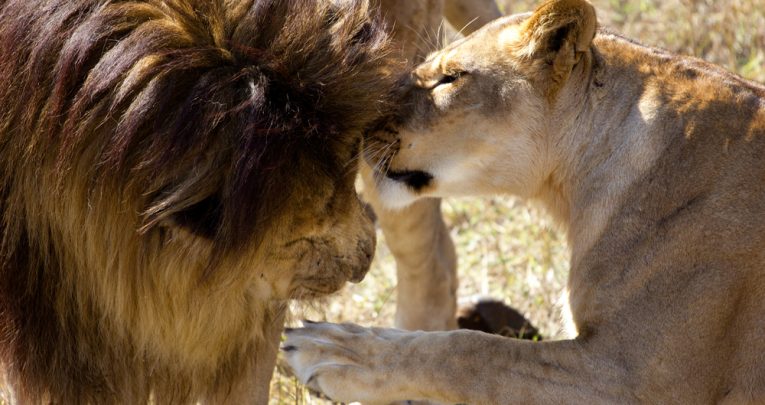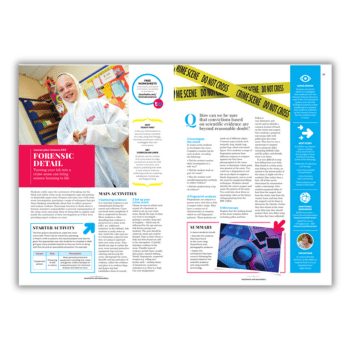KS3 Biology Lesson Plan – Get In The Mood For Animal Behaviours

Dr Joanna Rhodes has been watching wildlife – and it’s given her some brilliant ideas for teaching about learned and innate animal behaviours

- by Dr Joanna L Rhodes
- Vice principal at Leeds Mathematics School

You might think your pupils sometimes behave like animals. In this lesson you actually want them to! Get them up and about thinking about attraction and how and why animals perform elaborate rituals to attract a mate. This fun biology lesson aimed at KS3 links animal behaviour and evolution with dance!
To keep my teaching as fresh and inspiring for my students as possible I try to get ideas from the world around me.
As a science teacher, spotting interesting things that I can take back to the classroom and share with the class is a hobby of mine. Sometimes an idea for a whole lesson gradually builds during a week away and I come back bursting with ideas to craft into an experience for students.
I spent part of the Easter holidays visiting the spectacular Yorkshire coastline and while I was at the RSPB reserve on the top of Bempton Cliffs I experienced the familiar feeling of a teaching idea springing to mind. I was watching and photographing a stunning pair of gannets on a stack of limestone performing an elaborate fencing routine with their beaks.
As I looked around I saw all the other gannets behaving in the same way but the guillemots, puffins and razorbills were all performing to their mates in different ways and I started to think about attraction and the different ways that life has evolved to attract a mate. After visits to the foreshore, rockpools and clifftops I think I have a lesson to share with you.
Taster Activity
Get the class in hysterics by showing Eddie Redmayne teaching someone how to perform the seductive erumpent dance he created for Fantastic Beasts and Where to Find Them.
To get them even more ‘in the mood’ you could also show them an amazing weird and wonderful mating birds compilation set to music or perhaps the most colourful spider in the world, the peacock spider, performing a kind of semaphore to avoid being eaten by his mate. Then get your students outside in the fresh air to devise their own mating dances. While doing the activity you want them to think about what message the mating dance is trying to get across to the potential mate, and why a mating dance might be necessary. You could even team up with the dance department and ask some of the GCSE or A-level dance students to devise a courtship dance based on birds of paradise to demonstrate to the class. Ask students whether they think a courtship dance is learned by copying other animals (an environmental factor) or whether the animal simply “knows” what to do, innate behaviour because of genetics (an inherited characteristic).
Starter activity
Explain to students that the learning intention of today’s lesson is to understand the differences between learned behaviour and innate (instinctive) behaviour in animals. Begin by asking your students to discuss their personal experience with pets and any training methods they have tried. You could use the following prompt questions to help you:
| • | Why do people like pets? |
| • | Which kinds of pets can you train? |
| • | Why do some animals make better pets than others? |
| • | What training methods have you tried with your pets? |
Take a break and explain to students how all animals have inherited traits and characteristics in their genes that define what the animal can do. These innate traits evolved and get passed along in the offspring of each species. This is why right from birth a dog barks like a dog and doesn’t moo like a cow and why an orb web spider can spin a perfect web the first time it tries.
Other types of behaviour are learned through training or observing. For example you can teach a parrot to talk, or a dog to beg, or a cat to use a litter tray. None of these characteristics are innate. Now ask students to discuss the following questions:
| • | What is an example of an inherited trait in a pet? |
| • | What is an example of learned behaviour in a pet? |
| • | What are examples of inherited and learned traits in humans? |
| • | What are some species-specific traits in your pets? |
| • | What is something that your pet has learned? |
| • | Give an example of an innate behaviour demonstrated by both human and non-human animals |
To extend your more able students ask them to explain what is meant by the statement “Many of the problems we experience with our pets are normal species-typical behaviours that are inconvenient for us or occur in an inappropriate setting”.
Main Activities
1. Behaviours investigation In this activity students will apply their knowledge about learned and innate behaviours to a new animal. It adds interest and suspense to use a die to select the type of animal they will be investigating. On the first roll 1 is a mammal, 2 is a fish, 3 is a bird, 4 is a reptile, 5 is an amphibian and 6 is an insect.
On the second roll 1-2 is small, 3-4 is medium and 5-6 is large.
Students should then use the internet on tablets or computers to identify their animal of choice which they should draw or print out on the front of a tri-fold leaflet which could be produced by the whole group working together on an A3 piece of paper or individually on A4. Each page of the trifold leaflet should have a title and it should cover diet, habitat and behaviours for their animal.
On the back of the leaflet students should create a list of all the behaviours they can find for their animal. Pose the following questions to focus students in the way they think about and analyse the behaviours:
| • | How did your animal acquire the behaviour? |
| • | Which of your animal’s behaviours are learned and which are innate? |
| • | Are any of your animal’s behaviours linked to the environment or climate it is found in? |
| • | Do the animal’s physical characteristics help it in any way? |
2. Wildflowers observation Attracting a mate is more difficult if you are a plant. But plants have their own methods for attracting pollinators, which collect or move pollen from one flower to another either within a plant or between plants of the same species. In this activity students create a wildflower bed that you can use in future lessons through the summer term to observe the pollinators it attracts and the different shapes and colours of flowers. Challenge students to answer the following questions:
| • | Which colour of flower attracts the most insects? |
| • | Are large flowers or smaller flowers better for attracting insects? |
| • | Do native or non-native species of plant attract insects better? |
| • | Students could cultivate a cheaply available plastic raised bed, or you could even use outdoor window boxes in an urban setting. |
Summary
Evolution and attraction go hand in hand, because animals that mate successfully pass on their genes to their offspring, which then carry the same characteristics. Females generally select males rather than the other way round and it is easy to see how a feature that females find attractive can become more and more exaggerated with each generation as the gene is passed on.
Imagine a male bird with a small crest that females of the species find attractive. Males with the biggest crest are most successful and gradually the sizes of the crests increases until it is a very large and obvious plume of feathers on the top of their head.
Give students some examples of animals with a favourable mating characteristic such as a mane on a lion, a tusk on a walrus, big ears on an elephant, long legs on a spider, and ask them to draw the progression of that characteristic as it is passed on through the generations.
Expect lots of lions with giant manes, huge tusks, ears the size of bedsheets and enormously long-legged spiders.
Then ask the class what would limit the amount of exaggeration that a characteristic could have? Could you really have ears the size of bedsheets? Despite the sexual selection of these characteristics, these really exaggerated characteristics would impact on the ability of the animal to survive and not be preyed upon. In reality there is a balance between the advantage of the feature for mate selection and the disadvantages it might present for survival.
Home learning
As homework ask your students to write a creative short story about the animal they investigated during the lesson. The story should describe the animal’s survival, its instincts and its behaviours. In a future lesson you could photocopy and share some good examples and ask other students to identify which of the behaviours in the story are learned and which are instinctive.
Download this lesson plan as a PDF here.
Dr Joanna Rhodes M.Chem, D.Phil, MRSC is assistant principal for science at Shelley College in West Yorkshire.










